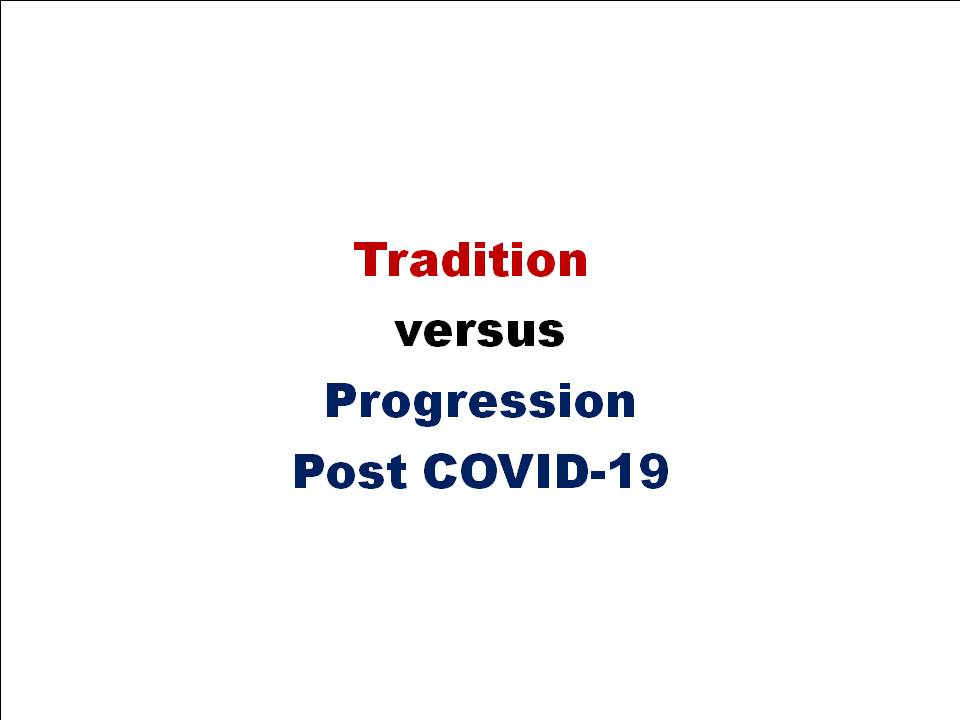by Peter A. Arthur-Smith, Leadership Solutions, Inc.®
‘As companies grow, they pump out more innovations. The problem is that they lose motivation to innovate once they become a monopoly.’ Christopher Mims, Technology Columnist at Wall Street Journal, June 2019

Scores of articles have already been written shouting-out the COVID-19 silver lining: the chance to break with the past and come up with fresh approaches to so many key issues. Scores of us have become momentarily excited as we contemplate our hope that so many things could and should change for the better. Why not? But then we move toward the realization that they don’t and will likely not have changed much when we look back in a year from now.
In typical people fashion we yearn for change and then quickly have second thoughts when we give so many ideas further scrutiny. We quickly get cold feet or shrink from the effort involved. Often this is because when we ponder change and then come to the conclusion that we have to change, too. Our nature is that we want everyone else and everything to change except ourselves. Are you familiar with that thinking?
Ironically the same thing happens within our organizations. There are lots of things we believe could be changed for the better, although inspiring people to embrace such advances is a major deal. It brings to mind a piano teacher who hails from Ukraine and now lives in Brooklyn, New York. She obviously fled to the US with her husband and many others from her generation owing to persecution and other challenges in her homeland. Even so, she still wishes at times that she could be back in her home town under the former communist regime, where jobs were secure for life even if the salaries weren’t great and you didn’t have much say in society. Every day, every week was predictable and her job was secure.
Your writer regularly contemplates the many fresh organizational ideas he’s proposing in his forthcoming book – Radical Leadership Breakthrough – but then doesn’t underestimate the challenges of encouraging enterprises to take advantage of them. Consider the very recent response of a management professor to this writer’s book outline: “Looks like you’re proposing some serious disruptions for organizations, Peter.’ Let’s just take two key examples:
» Problem Solving versus Option Solving – Traditionally we have solved our problems through a rational elimination process until we’re left with ‘either-or.’ That leaves you with a 50/50 chance of being wrong or partly wrong. With ‘option solving’ you are expected to come up with at least five alternatives, which likely means you will reduce your chances of error to 20%. That’s particularly likely as you will fully involve your intuitive capabilities which are reportedly 22,000 times more powerful than your rational capabilities. Your intuition gives you a much greater chance of being right based upon all your life’s experiences to date…all your life’s experiences are stored somewhere in that 3lb computer you possess, known as your brain.
» Strategic Planning versus Strategic Positioning – We continue to rely upon Strategic Planning (SPl) and its associated SWOT analysis. In Henry Mintzberg’s view, who was among the early founders of SPl around 50 years ago, he ultimately recognized Strategic Planning as an oxymoron: that is, you cannot conceptualize (strategize) and analyze (plan) simultaneously.
By pursuing Strategic Positioning (SPo) and its use of a powerful, four-dimensional ‘Strategic Framework’ – Vision &Purpose, Knowhow, Resources and Outcomes – we stimulate our minds to visualize our journey and potential destination. (NOTE: For dynamic organizations their destinations are constantly evolving.)
There are a number of other key areas where we need to abandon our traditional approaches and take on fresh leadership thinking like:
» How we motivate people? Through intrinsic (inspiring) modes versus extrinsic (driving) modes
» How we utilize people? Through pairing people together in your workplace, where they are a multiplier rather than as individual operators. The right two people combined can produce more than two people working alone.
»How we organize people? Instead of using hierarchies, which are an anathema as they only grow from top-down unlike every other organic item on our planet, we turn to heterarchies. ‘Heterarchies’ allow leaders to orchestrate their teams or enterprises from the center rather than from the pinnacle.
»How we focus and monitor our progress? We currently tend to utilize a step-by-step, goal oriented process, which can have a stop-start effect and impede our momentum: whereas, we can apply a phased streaming and flow approach to build continuous momentum.
There are many more fresh leader-oriented ideas emanating from this book. Even so they require determination, fortitude and goodwill to encourage people to switch over and reap the benefits. Like anything else that’s worthwhile pursuing, it requires enlightened leaders to shine the light and then insightfully educate and encourage people to observe desired changes until they materialize. Once fully installed, everyone will feel greater possibilities, more empowerment, and enhanced fun in advancing their vision and journey.
While so many things have changed over the past hundred years relatively speaking, not much has changed in the way we organize ourselves and allow all those involved to demonstrate their full talents. By sticking with ‘traditional think,’ society is likely to choke on the dissonance between so many new world ideas held together by old world organization traditions.
To learn more about envisioning and decision clarity, talk with:
